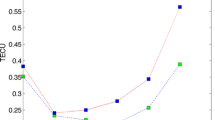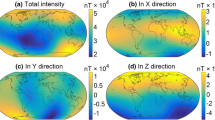Abstract
Compensation for differential code bias (DCB) is necessary because it is the major source of errors in total electron content (TEC) measurements. The DCB estimation performance is degraded when only the regional GPS network is used. Because DCB estimation is highly correlated with ionospheric modeling, this degradation is particularly evident for measurements concentrated in an area of high TEC concentration. This study proposes a DCB estimation method that uses the long-term stability of the DCB to improve the estimation performance of the regional GPS network. We estimate satellite DCBs by assuming their constancy over seven months. This extended period increases the number of measurements used in DCB estimation and changes the local time distribution of collected measurements. As a result, the unbalanced distribution of specific ionospheric conditions disappears. Tests are performed using both global and regional networks, and the estimation performance is evaluated based on the position error and pseudorange residuals. First, the difference between the global and regional networks when using the conventional method is analyzed. Second, proposed methods are applied to regional networks. The proposed method can improve the DCB estimation performance, and the results are similar to those obtained using one-day global network data.




















Similar content being viewed by others
References
Arikan F, Nayir H, Sezen U, Arikan O (2008) Estimation of single station interfrequency receiver bias using GPS-TEC. Radio Sci. https://doi.org/10.1029/2007rs003785
Chao (1997) Real time implementation of the wide area augmentation system for the global positioning system with an emphasis on ionospheric modeling. Ph.D. dissertation, Stanford University, Stanford
Choi BK, Cho JH, Lee SJ (2011) Estimation and analysis of GPS receiver differential code biases using KGN in Korean Peninsula. Adv Space Res 47(9):1590–1599. https://doi.org/10.1016/j.asr.2010.12.021
Durmaz M, Karslioglu MO (2015) Regional vertical total electron content (VTEC) modeling together with satellite and receiver differential code biases (DCBs) using semi-parametric multivariate adaptive regression B-splines (SP-BMARS). J Geodesy 89(4):347–360. https://doi.org/10.1007/s00190-014-0779-8
Feltens J, Schaer S (1998) IGS products for the ionosphere, In: Proceedings of IGS 1998 analysis center workshop, ESOC, Darmstadt, Germany, February 9–11, pp 225–232
Gao Y, Petit G, Schaer S (2008) Session on calibration and future receiver developments, Part I: Calibration. In: IGS workshop 2008, June 2–6, Miami Beach, Florida, USA
Hauschild A (2015a) Correlator- and Front-end-dependency of GNSS pseudorange biases for geodetic receivers. IGS workshop 2015, November 5–6, Bern, Switzerland
Hauschild A (2015b) The effect of correlator and front-end design on GNSS pseudorange biases for geodetic receivers. In: Proceeding of ION GNSS + 2015, Institute of Navigation, Tampa, Florida, USA, September 14–18, 2015, pp 2835–2844
Hauschild A, Montenbruck O (2016) A study on the dependency of GNSS pseudorange biases on correlator spacing Gps. Solutions 20(2):159–171. https://doi.org/10.1007/s10291-014-0426-0
Jin R, Jin S, Feng G (2012) M_DCB: Matlab code for estimating GNSS satellite and receiver differential code biases. GPS Solut 16(4):541–548. https://doi.org/10.1007/s10291-012-0279-3
Kao S, Tu Y, Chen W, Weng DJ, Ji SY (2013) Factors affecting the estimation of GPS receiver instrumental biases. Surv Rev 45(328):59–67. https://doi.org/10.1179/1752270612y.0000000022
Kao S, Chen Y, Ning F (2014) A MARS-based method for estimating regional 2-D ionospheric VTEC and receiver differential code bias. Adv Space Res 53(2):190–200. https://doi.org/10.1016/j.asr.2013.11.001
Kee C, Walter T, Enge P, Parkinson B (1997) Quality control algorithms on WAAS wide-area reference stations. Navigation 44(1):53–62
Kouba J (2009) A guide to using International GNSS Service (IGS) products. International GNSS Service (IGS), https://igscb.jpl.nasa.gov/igscb/resource/pubs/UsingIGSProductsVer21.pdf. Accessed 10 Nov 2016
Li LX, Zhang DH, Zhang SR, Coster AJ, Hao YQ, Xiao Z (2015) Influences of the day-night differences of ionospheric variability on the estimation of GPS differential code bias. Radio Sci 50(4):339–353. https://doi.org/10.1002/2014RS005565
Ma G, Maruyama T (2003) Derivation of TEC and estimation of instrumental biases from GEONET in Japan. Ann Geophys 21(10):2083–2093
Ma GY, Gao W, Li JH, Chen YH, Shen H (2014) Estimation of GPS instrumental biases from small scale network. Adv Space Res 54(5):871–882. https://doi.org/10.1016/j.asr.2013.01.008
Mannucci A, Iijima B, Lindqwister U, Pi X, Sparks L, Wilson B (1999) GPS and ionosphere. In: Stone WR (ed) Review of radio science 1996–1999. Oxford University Press, Oxford, pp 625–665
Rui T, Qin Z, Guanwen H, Hong Z (2011) On ionosphere-delay processing methods for single-frequency precise-point positioning. Geod Geodyn 2(1):71–76
Sardon E, Zarraoa N (1997) Estimation of total electron content using GPS data: how stable are the differential satellite and receiver instrumental biases? Radio Sci 32(5):1899–1910. https://doi.org/10.1029/97rs01457
Sardon E, Rius A, Zarraoa N (1994) Estimation of the transmitter and receiver differential biases and the ionospheric total electron-content from global positioning system observations. Radio Sci 29(3):577–586. https://doi.org/10.1029/94rs00449
Schaer S, Beutler G, Mervart L, Rothacher M (1995) Global and regional ionosphere models using the GPS double difference phase observable. In: Proceedings of the IGS Workshop on Special Topics and New Directions, May 1995, Potsdam, Germany. pp 77–92
Seo J, Walter T (2014) Future dual-frequency GPS navigation system for intelligent air transportation under strong ionospheric scintillation. IEEE Trans Intell Transp Syst 15:2224–2236. https://doi.org/10.1109/Tits.2014.2311590
Song S, Xue J, Zou Z (2016) The stability analysis of GNSS satellite DCB. In: IGS workshop 2016, February 8–12, Sydney, NSW, Australia
Xue J-C, Song S-L, Zhu W-Y, Lu X-S (2012) A study on the reliability of the ionospheric VTEC and satellite DCB derived from a regional GPS network chinese astronomy and astrophysics 36(1):73–85. https://doi.org/10.1016/j.chinastron.2011.12.008
Zhang D, Shi H, Jin Y, Zhang W, Hao Y, Xiao Z (2013) The variation of the estimated GPS instrumental bias and its possible connection with ionospheric variability. Sci China Technol Sci 57(1):67–79. https://doi.org/10.1007/s11431-013-5419-7
Zhong J, Lei J, Dou X, Yue X (2015) Is the long-term variation of the estimated GPS differential code biases associated with ionospheric variability? GPS Solut 20(3):313–319. https://doi.org/10.1007/s10291-015-0437-5
Acknowledgement
This research was supported by Development of Space Core Technology Program through the National Research Foundation of Korea (NRF) funded by the Ministry of Science, ICT and Future Planning (NRF-2017M1A3A3A02016230), contracted through the Institute of Advanced Aerospace Technology.
Author information
Authors and Affiliations
Corresponding author
Rights and permissions
About this article
Cite this article
Han, D., Kim, D. & Kee, C. Improving performance of GPS satellite DCB estimation for regional GPS networks using long-term stability. GPS Solut 22, 13 (2018). https://doi.org/10.1007/s10291-017-0669-7
Received:
Accepted:
Published:
DOI: https://doi.org/10.1007/s10291-017-0669-7




